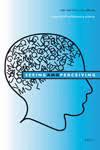Two-point touch discrimination depends on the perceived length of the arm
引用次数: 0
Abstract
Two-point discrimination threshold depends on the number and size of receptive fields between the touches. But what determines the size of the receptive fields? Are they anatomically fixed? Or are they related to perceived body size? To answer this question we manipulated perceived arm length using the Pinocchio illusion. The test arm was held at the wrist and the holding arm was made to feel perceptually more extended than it was by applying vibration to the tendon of the biceps (cf. de Vignemont et al., 2005). For control trials the holding arm was vibrated elsewhere. An array of tactors, separated by 3 cm, was placed on the upper surface of the arm and covered with a cloth. Vibro-tactile stimulation was applied to either one or two tactors in two periods. Subjects identified which period contained two stimuli. A psychometric function was drawn through the probability of correct response as a function of tactor separation to determine the threshold distance. In a separate experiment, subjects estimated the perceived location of each tactor against a scale laid on top of the cloth. The estimated locations of the tactors on the tested arm were displaced by tendon vibration of the holding arm compatible with a perceptual lengthening of the arm. The threshold for two-touch discrimination was significantly increased from 4.5 (±0.6) cm with no tendon stimulation to 5.7 (±0.5) cm when the arm was perceptually extended. We conclude that two-point touch discrimination depends on the size of central receptive fields that become larger when the arm is perceptually lengthened.两点触摸辨别取决于感知到的手臂长度
两点辨别阈值取决于触摸之间的感受野的数量和大小。但是是什么决定了接收野的大小呢?它们在解剖学上是固定的吗?或者它们与感知到的体型有关?为了回答这个问题,我们使用匹诺曹错觉来操纵感知到的手臂长度。将测试臂放在手腕处,通过对肱二头肌肌腱施加振动,使测试臂在感知上比实际更伸展(cf. de Vignemont et al., 2005)。在控制试验中,控制臂在其他地方振动。一组因子,间隔3厘米,放置在手臂的上表面,并用一块布覆盖。振动触觉刺激在两个时间段内分别作用于一个或两个因素。受试者确定哪段时间包含两个刺激。通过正确反应概率作为因子分离的函数,绘制心理测量函数来确定阈值距离。在另一个单独的实验中,受试者根据放在布上的刻度估计每个因素的感知位置。测试臂上因子的估计位置被与手臂知觉延长相容的保持臂的肌腱振动所移位。两触辨别阈值从无肌腱刺激时的4.5(±0.6)cm显著增加到手臂知觉伸展时的5.7(±0.5)cm。我们得出的结论是,两点触摸辨别取决于中央感受野的大小,当手臂知觉延长时,中央感受野会变大。
本文章由计算机程序翻译,如有差异,请以英文原文为准。
求助全文
约1分钟内获得全文
求助全文

 求助内容:
求助内容: 应助结果提醒方式:
应助结果提醒方式:


